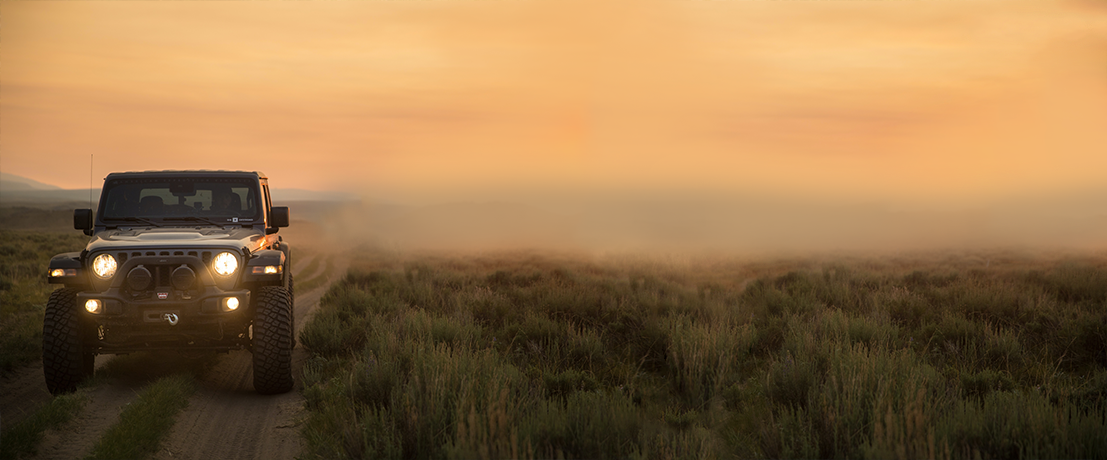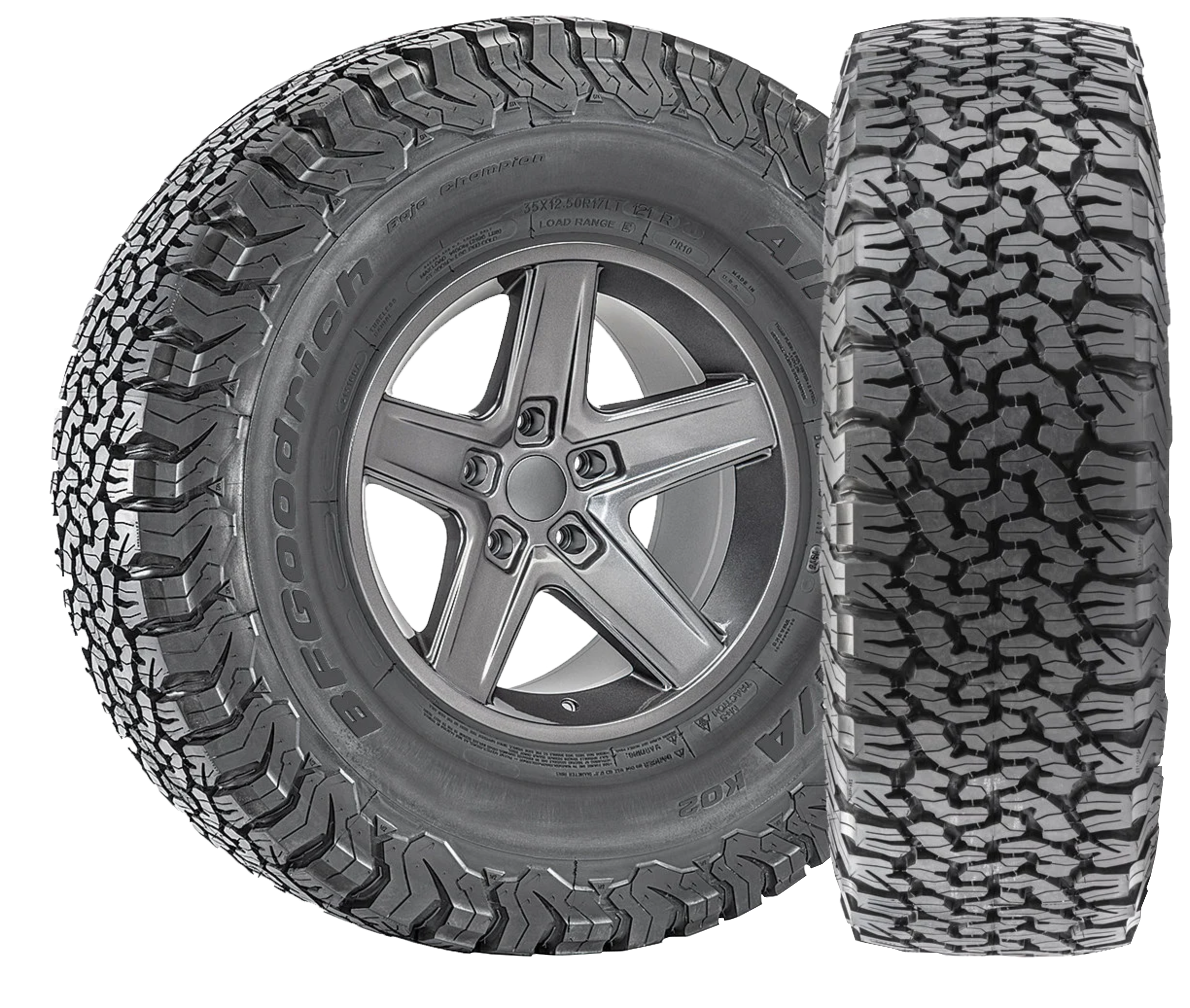BFGoodrich 4WD Off-Road Tips
4WD vehicles are designed to drive through obstacles that conventional vehicles would not be able to overcome. With that in mind, BFGoodrich has put together some 4WD off-road tips and tricks to help you enjoy your 4WD experience!
Driving on Sand
A key to driving on sand is steadily maintaining momentum to give your tyres a chance to roll over the top of the sand rather than dig into it. For softer sand, keep the balance of acceleration and momentum to avoid your tyres digging in, but not so much power that the wheel-spin you create enables your tyre to dig its own way down. Avoid any violent or sudden moves or sharp turns on the steering wheel, as the vehicle won’t respond. Instead, you’ll just plough ahead like under-steering on a wet road. A 4WD vehicle is prone to toppling over due to their high centre-of-gravity and tyres can cut into the sand violently causing the vehicle to trip and fall over. It’s recommended that you turn in big wide arcs with plenty of time before reaching the bend or the obstacle. If you’re forging new tracks, you’ll need more power so you’re not getting stuck.
Tyre Pressure
BFGoodrich recommends that you carry a quality tyre pressure gauge and drop your tyre pressures by 5psi at a time until you reach your optimal footprint on the sand that you’re driving in. BFGoodrich advises not to drop your tyre pressures to under 20psi. By dropping your tyre pressure, you’re increasing the tyre’s footprint on sand, increasing the area of contact between your vehicle and the road.
Avoid driving back to town to reinflate your tyres. If you don’t have an air compressor, BFGoodrich recommends that you drive very slowly and not long distances to ensure that your tyres don’t overheat. At 20psi you don’t want to be going any faster than 25km per hour.
Things to Consider
- Check tide times and drive at low tide if you’re driving on beaches.
- Momentum is your best friend on sand.
- Use a proper tyre gauge and don’t guess your tyre pressures.
- Deflate your tyres by 5psi at a time to increase your tyre’s footprint until you reach optimal traction.
- Be smooth in acceleration, steering and braking.
- If your wheels start to spin, ease off the acceleration a little to let the tyres slow down and regain traction.
- Don’t follow other vehicles too closely.
What to Do When Driving Up Hills and Steep Terrain
Driving up hills and steep terrain is one of the most exciting and dangerous activities you can do in your 4WD.
Exciting because it’s adventurous and you’re living on the edge and dangerous because there’s a high risk of you rolling your vehicle and by ‘rolling’ BFGoodrich means by rolling all the way down.
When Ascending Hills
Before you rev your engine and charge up the hill, this is a good chance to step outside your vehicle and do some exercise by checking the track in advance to ensure there are no obstacles on route and a clear exit at the top. A surprise cliff at the end makes for a very bad day. Use a high gear – if the gear is too low you will spin the tyres, if it’s too high you will lose power.
BFGoodrich advises you start by selecting 2nd gear, low ratio and use a short run up to gain momentum. Try to gauge your momentum so you climb the hill at a walking pace and no faster. Never change gear or direction once you’ve committed to a hill and be prepared to lose vision as the sky may fill your windscreen on a steep climb – this is why you check beforehand to ensure there’s no surprise cliff at the end.
Make sure you approach the hill straight on so the weight is distributed equally, providing equal traction to all four tyres.
Use the highest gear the vehicle will handle comfortably on the hill. If the gear is too low, you will spin the tyres. If it’s too high, you won’t have enough power. Always prepare for a failed climb and have an escape plan.
What to Do if You Don’t Make It Up the Hill
Don’t fret if you don’t make it up the climb the first time, this happens to both novice and experienced drivers. However, if you don’t make it up the climb, it’s very important to know how to get back down safely. It doesn’t sound hard, but it’s riddled with dangers.
If you’re losing control of your vehicle down a steep gradient and going backwards, your first reaction is to kick the clutch to prevent the engine from stalling – Don’t do this. If you put your foot on the clutch, it means you no longer have forward drive – worst of all – you are helping gravity to roll your vehicle backwards quicker.
Once the backwards rolling has started and if you’re not kicking the clutch, your next automatic reaction is to pump the brakes. On a steep gradient, this also won’t help you. The backwards momentum of your vehicle will send you into a slide, but with no wheel rotation, you’ll lose your ability to steer your vehicle.
Help! I’m rolling!
I am rolling down a hill backwards and I can’t put my foot on the brake or clutch, what do I do?
So you’ve reached that moment of truth with the hill you’re trying to conquer and have realised you don’t have enough momentum to take you over the top… Instead of jumping out of your car here’s what you do to get back down.
- Don’t touch the clutch – this is harder than you think.
- While you’re going into your engine stall, depress the foot brake slowly and smoothly.
- Pull your hand brake. Now you have three mechanical elements that prevent you from rolling backwards: you’re still in gear, your foot brake and your hand brake.
- If someone can get out of the car to guide you back down great, but don’t get out of the car yourself as this means you’re releasing the foot brake.
- Put your foot gently back on the clutch.
- Shift your vehicle into reverse gear and engage in low range.
- Slowly take your foot off the clutch.
- With your foot still on the foot brake, slowly release the hand brake.
- Carefully and slowly remove your foot brake.
- With the reverse gear engaged and the engine off, you should remain still.
- Restart your engine with your foot off the clutch to let the car’s engine braking control to assist in your descent.
- You should now be on your way back down, but try not to touch the accelerator or brake.
- If the hill is steep, you may need to tap the brakes gently, but this is risky as you may lock your wheels and trigger a slide.
- Once you’ve made it back to the bottom, have another go, but try a different tact. If it didn’t work the first time, it probably won’t work on the second go. Instead try a different route, change your tyre pressure or mule some equipment up the hill on foot.
Stall Recovery Technique for Automatic Vehicles
For those of you with fancy automatic transmissions here’s what you do if you get stuck up a hill:
- Put your foot on the brake.
- Pull your hand brake.
- If you’ve stalled your engine, put the transmission into ‘Park’. Now you have three mechanical elements that prevent you from rolling: Your transmission is still in drive or park mode, your foot brake and your hand brake.
- If someone can get out of the car to guide you back down great, but don’t get out of the car as this means you’re releasing the foot brake.
- If your engine has stalled then you need to restart it.
- Shift your transmission into Neutral.
- Engage in Low Range.
- Shift your transmission into Reverse.
- With your foot brake depressed, carefully release the hand brake.
- Slowly remove the foot brake to start your controlled descent.
- You should now be on your way back down, but try not to touch the accelerator or brake.
- If the hill is steep, you may need to tap the brakes gently, but this is risky as you may lock your wheels and trigger a slide.
- Once you’ve made it back to the bottom, have another go, but try a different tact. If it didn’t work the first time, it probably won’t work on the second go. Instead try a different route, change your tyre pressure or mule some equipment up the hill on foot.
In your conquest of hills, you’ll need as much traction available to you as possible and to help you achieve this, you may want to reduce your tyre pressure before you start your ascend. There’s no recommended tyre pressure for this, as different terrains will need different tyre pressures, but remember you don’t want to puncture your tyre halfway up the hill, so be conservative when deflating your tyres.
Descending Steep Hills
Going down a steep hill in your 4WD is much easier than going up, for a start you’re facing the right way with better visibility than going uphill and you’ve also got gravity on your side. However, gravity isn’t always a good thing when the gradient is too steep, therefore like driving uphill, retaining traction will be the key to your successful descent.
- Take a look at the track and walk down beforehand. If you can’t walk down the track, then more than likely you won’t be able to drive down it.
- Have a contingency, if you’re in your vehicle and lose control or it gets too steep for your liking, you’re going to need a backup plan before your descent. Just remember this may mean reversing up a steep hill, so choose your descent carefully!
- Tyre pressure, like going uphill you’re going to need as much traction as possible. There’s no optimal tyre pressure for this, as different pressures will apply to different terrains so deflate your tyres conservatively.
- Decide on the best path for your vehicle to descend, usually, an existing path that someone else has used is a good start.
- Use low-range gear, if you don’t your car will run away.
- Use first gear – a combination of low range and first gear will help your car’s engine brake control your descent down.
I’m Not Going to Make It Down Safely, What Do I Do?
If you’ve decided it’s no longer safe to keep going down the hill, then you’re going to need to come to a safe stop and reverse back up. Supposing that you’ve taken the correct precautions and used the recommended technique above, you shouldn’t be going that fast.
Apply the foot brake gently and smoothly, don’t slam the brakes as it puts you at risk of locking the wheels and losing control. Once you’ve come to a stop, pull your hand brake and put your vehicle in reverse. Reverse back up the way you’ve come.
Driving Across Steep Slopes and Hills
According to the experts, this is the most difficult exercise in four-wheel-driving. Our first recommendation on this subject is quite simple – avoid it at all costs. However, if you do decide you need to traverse across a steep slope or hill then you should do it as slowly as possible.
- Make sure your tyres are well inflated (inflate to on-road pressures), if they’re not inflated they’ll come off the rim.
- Put your car in low-range first gear without the differential lock
- Drive as slow as possible across the slope and if you feel your car starting to slide, turn your steering wheel immediately in the direction of the slope
Caution: Remember your 4×4 vehicle has a high centre of gravity. Driving across steep hills sideways dramatically increases your chance of losing traction. If you lose traction, you’ll slide sideways and probably roll your vehicle… So please avoid driving across slopes as much as possible.
What to Do When Driving in Mud Ruts
Oh, mud, glorious mud, get it right and you’ll have some of the best fun in your 4WD. Get it wrong and you and your car will be seriously dirty. Having the proper mud tyres are vital in this application, as the idea is to get the full weight of your vehicle to push the tyres through the mud in an attempt to grip onto the firm ground underneath.
There’s no optimal tyre pressure for this, as every situation and terrain will require different pressure. But remember if the pressure is too low, you’ll spread the weight of the vehicle too much, therefore, not getting maximum traction. If the pressure is too high, you won’t get the required grip to traverse through the mud. A general rule of thumb is to not go below 20psi and not travel faster than 20kmh.
- Ensure you have a winch on your vehicle in case you get stuck.
- Check your route first and see how deep the mud is – ruts deeper than the clearance under your vehicle’s axles will get you stuck.
- Approach the mud in 4WD and low gear and remember to build some momentum and prepare for the sudden deceleration upon contact with water and mud.
- Maintain a steady pace the whole way through and keep to the high points of the track if possible.
- If you’re stuck, rock the vehicle by alternating between first and reverse gears gently, or spin the wheels a little to clean the tyre tread to restore traction.
- If in doubt reverse out before it’s too late.
Climbing Over Rocks, Logs, Ditches and Mounds
The modifications you’ve made – or going to make – to your vehicle are very important in conquering this type of terrain. Good ground clearance is what allows rocks, logs and ditches to pass underneath your vehicle without breaking fragile components on the underside of your car. While good suspensions are what keep your tyres in contact with the ground.
Approach obstacles at an angle, so that only one tyre engages, leaving the other three tyres on solid ground for traction
To protect the fragile components on the underside of your vehicle, it’s best to drive over an obstacle by placing one tyre on it, and then gently driving over it.
Note: If the obstacle is too severe, it can cause the vehicle to become cross-axled, meaning the diagonally opposite wheels will lift clear off the ground resulting in no drive.
When Crossing Water
If you’re afraid of water, then we suggest you don’t think about doing this as, nine times out of ten, you’re going to get wet. 4WD vehicles can frequently tackle water with some able to go deeper than others due to the installation of snorkels, but this depends on the water you’re crossing as well as the current and flow. Water should never be driven through fast, therefore maintaining a steady speed that creates a gentle ‘bow wave’ at the front of your vehicle will be the key to your success. When your crossing has been completed, always remember to drive a short distance with your foot slightly depressed on the foot brake to restore braking efficiency.






